RIGHT TURN ONLY!!
Like a Girl Out of Hell
by Carlo Santos,

As I was watching the first two episodes of the Honey and Clover TV drama, I spent about 98% of the time mentally comparing it to the manga and anime and wondering why H&C is unadaptable to live-action. The movie tried, but lacked the warmth and joy of the series, and now the drama was making its own share of missteps. Casting a 15-year-old who looks about 20 as Hagumi. Changing the circumstances of how Takemoto and Hagu-chan meet. And why, why in the name of God is Nakatsu from Hana-Kimi playing Takemoto?
And then the last scene from Episode 2 happened, and I was won over.
DAMN YOU MORITA!
DO YOUR BEST, TAKEMOTO!
Hagu-chan ... my love.
It's not the definitive Honey and Clover, but it has its heart in the right place. And its funnybone, too, which the movie so sorely lacked. I'll keep on watching.
.HACK//G.U.+
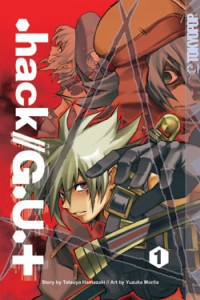
Vol. 1
(by Tatsuya Hamazaki and Yuzuka Morita, Tokyopop, $9.99)
FROM THE BACK COVER:
"It is the year 2017, and the stakes have gotten even higher in the massively multiplayer online game The World—now The World R:2, a dangerous place overrun by player killers, where lawlessness abounds. The PKK Haseo, known as 'The Terror of Death,' is a fearsome foe who punishes those who want to slay other players. But things have gotten personal as Haseo tries to track down the killer Tri-Edge, who has threatened the real life of his friend Shino..."
EVIDENCE FOR:
Sometimes, a reboot is necessary. With the events of G.U.+ taking place in a new, next-gen version of The World, newbies to the .hack series can jump into this one without having to know too much about previous events—just your basic background knowledge about how online games work. The driving mystery behind the story—are there really Player Killers out there who can injure people in real life?—is strong enough to keep readers hooked, and the fast-paced layouts (only a few lines of dialogue per page) keep things focused on the action. And if it's action you're after, the second half of this volume will definitely satisfy, with its crazy combat outfits, powerful creature/spirit/summon thingys, and deadly attacks. Haseo may be a ruthless fighter, but he's got a noble heart and wants to save his injured friend—and that's why we're rooting for him.
EVIDENCE AGAINST:
Just when this volume starts to get interesting and mysterious—a gamer lying comatose in a hospital, an elite player trying to unravel the cause of her malady, and a secret organization of developers looking into the crisis—it quickly turns into a boring, drawn-out slugfest. Sure, action fans may be satisfied with the combat in the later chapters, but it's the manga equivalent of button-mashing. Starting out with a half-decent story and devolving into generic arena combat ... that's never a good sign. And even worse than the generic arena combat is the generic RPG look for the series: horribly cheesy outfits with no fashion sense (what's with all the exposed midriffs and impractical accessories?), style-challenged backgrounds that give no sense of place, and of course, just your same old wide-eyed spiky-haired protagonist. Besides, now that actual online games have practically caught up with the .hack concept, the situations here feel dated and contrived: a girl getting all weepy over the moral implications of Player Killing? Developers hanging out on the servers and secretly looking for game-breaking bugs? Seriously, if you have enough free time to read a comic about online gaming, you might as well get a life and go play some World of Warcraft.
FINAL VERDICT:
It starts out with an intriguing premise and moves at a good pace, but the eventual downslide into endless combat and numerous gaming clichés land this one at a C-.
HELL GIRL
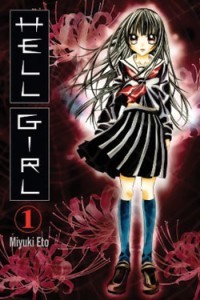
Vol. 1
(by Miyuki Eto, original concept by Jigoku Shoujo Project, Del Rey, $10.95)
FROM THE BACK COVER:
"When you thirst for revenge, there's a surefire way to get it: Simply go to the strange website that appears only at midnight, and enter the name of your enemy. The Hell Girl will appear to drag your tormentor to eternal damnation. But you will have to pay a price ... your soul!"
EVIDENCE FOR:
Unlike many other anime-to-manga conversions, Hell Girl is pretty solid entertainment in its own right, no previous experience required. The premise is easily understood, the page layouts flow well enough to reveal a logical plotline, and (perhaps most surprisingly) Eto dares to deviate from the anime and actually pulls it off. Indeed, the best stories in this volume are the ones that go for original content: the tale of a creepy science teacher preying on his nubile young students, or the one where two rival actresses fall victim to the superstition of appearing in a horror production. (Okay, so there was an episode in the anime about rival actresses as well, but that was way different.) Yet even the chapters based on previous plotlines have their own unique quirks: the revenge scenes for the unscrupulous vet and the plagiarizing baker have a couple of striking visual surprises that definitely weren't there in the original episodes. It may not be moving pictures in color, but Miyuki Eto proves that there are plenty of ways to be creep you out on paper.
EVIDENCE AGAINST:
Like many anime-to-manga conversions, this is simply a shallow, watered-down interpretation of the original series. Those expecting slick production values funded by Aniplex will instead be greeted by generic linework and toning patterns, overly huge eyes, and a Hell Girl who looks more like a shoujo heroine playing dress-up than the agent of the underworld that she's supposed to be. Her acts of vengeance are also not nearly as convincing, as she goes through the motions and follows the script but fails to deliver that same ominous presence that works onscreen. After all, it's just not Hell Girl without the flaming chariot in the sky, you know? And don't get me started on how they fudged the flower-pattern kimono effects. The simplified plotlines also rob the stories of their depth; don't expect any wicked twists or subtle pacing in this one. It may be following the correct formula for revenge-horror, but it definitely doesn't have the heart. Think of this as Hell Girl Lite.
FINAL VERDICT:
It's wonderfully accessible, even for those who haven't seen the source material, but the shallow storytelling and average art place this at a C+.
MANGA SUTRA: FUTARI H

Vol. 1
(by Katsu Aki, Tokyopop, $19.99)
FROM THE BACK COVER:
"At the age of twenty-five, newlyweds Makoto and Yura are still virgins. But not for long! That is, if they can figure out how everything works. Will the sweet—and voluptuous—Yura enjoy her first 'experience'? Or is Makoto not yet savvy enough to light her fire? Follow the hot young couple as they step up into love and experiment with getting it on ... and on ... and on!"
EVIDENCE FOR:
Katsu Aki's foreword says it best: "This isn't just a hentai manga. It's about love, sex and how-to..." And in that respect, it's a surprisingly interesting piece of smut, riddled with tips and facts (what percentage of the male population masturbates regularly? Find out inside!) that apply to actual, normal sexual relationships. If anything, it reads more like a "lifestyle guide" than any sort of saucy romance or explicit porn; the story is merely a vehicle for learning the basics about sex. That said, however, the characters are still interesting enough in their own right—Makoto's overeager desire to please Yura is amusing (nothing funnier than when he struts into the bedroom calling out, "Oh Yura-saaan!"), and Yura's fluctuating moods add the necessary level of push-and-pull conflict in the relationship. Even the side characters are entertaining, like Makoto's pompous older brother and Yura's slutty little sister—hey, the factoids and advice have got to come from somewhere, right? If you wanted to know everything about sex but were afraid to ask, at least now you can get some visual entertainment out of it, instead of going through an overhyped self-help book with some scary-looking "doctor" on the cover.
EVIDENCE AGAINST:
Believe it or not, this series does come with an ongoing storyline—but it's as weak as they come, centering on Makoto's problems with premature ejaculation. As one can imagine, Makoto's concern with making himself last longer isn't quite as dramatic as, say, "I've gotta be the greatest ninja!" Add the fact that Yura channels every young submissive female stereotype ever ("Oh, this is so embarrassing"), and it becomes a dreary exercise in watching this inexperienced couple fumbling around and learning things that any decently-educated adult should already know. However, the real barrier to pleasure here might be the not-so-sensual art—oh, Katsu Aki can draw just fine, but the style is laughably dated: big-haired girls, super-shiny eyes, and high-waistline panties galore. Even more laughable are the cross-sectional diagrams, which despite being a clever way of skirting obscenity laws, are about as erotic as a high-school biology textbook. It may be a decent "lifestyle guide," but the real thing is always better.
FINAL VERDICT:
So what if it looks a bit old-fashioned? Do you know how refreshing it is to read an adult manga that doesn't make you feel like a pervert or a moron? Give it a B and give it a try.
STRAWBERRY PANIC
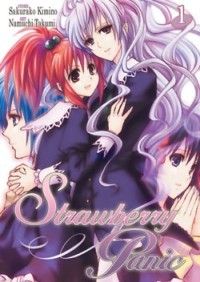
Vol. 1
(by Sakurako Kimino and Takuminamuchi, Seven Seas, $9.99)
FROM THE BACK COVER:
"For new transfer student Aoi Nagisa, St. Miator Girls' Academy offers her the chance at a fresh start and a way to redefine herself for the better. Now if only she could figure out where those darn dorm rooms are ... and that's when girl meets girl!
Enter Hanazono Shizuma, whose porcelain white skin and goddess-like beauty leaves Nagisa utterly speechless. But little does she know that Shizuma is a heartbreaker who has set her sights on Nagisa. Will Nagisa end up another notch in Shizuma's belt or does fate have other plans in store for the new couple?"
EVIDENCE FOR:
If it's schoolgirl drama you want, it's schoolgirl drama you'll get—Strawberry Panic does not dilly-dally around when it comes to the emotional ups and downs of yuri relationships. Volume 1 jumps into the action almost immediately, with Nagisa and Shizuma's special bond building up quickly within just the first few chapters. It's also quick to develop numerous other pairings for maximum love-polygon potential, from unrequited upperclassman adoration to cuddly sisterly love. And believe me, there is plenty of cuddling to be had here, whether it's hot forbidden library action, public-bath fun times, or simply two girls being close to each other in that painfully sweet, blush-inducing way. The introduction of the "Etoile" Competition in the later chapters also adds an element of conflict that should help keep the story moving along in a specific direction. With cute, doe-eyed characters and a soft, almost Impressionistic style to the backgrounds, this is definitely a dreamlike experience on both the visual and emotional level.
EVIDENCE AGAINST:
Maybe I'm just completely spoiled by the brilliance of Kashimashi and Aoi Hana, but there's only one convincing relationship so far in this series, and even that one feels underdeveloped and shallow. The story is, of course, designed to make us root for Nagisa and Shizuma—but the way Shizuma suddenly "chooses" her, and the way Nagisa gives in so easily, all seem to happen as arbitrary rapid-fire events. And if the main couple's storyline is being rushed, just imagine how all the side characters are being handled: rivals and friends flit about like hyperactive mosquitoes, appearing for a couple of pages before rushing off again into subplot oblivion. Take the Student Council members, for example, who seem to exist solely for the sake of making catty remarks and engaging in confusing rivalries. Not that anyone's going to remember who they are anyway, since all those doe-eyed girls look the same. This is one school soap opera that's in desperate need of more substance.
FINAL VERDICT:
A quick, lighthearted pace and girly-girl romance scenes are the big draw here, but the shallow characters and storyline knock this down to a C+.
VAMPIRE HUNTER D
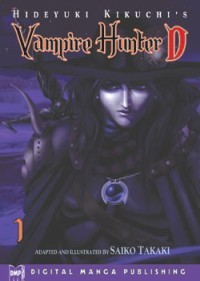
Vol. 1
(by Hideyuki Kikuchi and Saiko Takaki, DMP, $12.95)
FROM THE BACK COVER:
"The year is 12,090 A.D., and what little is left of humanity has finally crawled out from the ashes of war and destruction. From the darkness of fallout, mutants and a race of vampires known as the Nobility have spawned. They rule the weak with no remorse. Once bitten by a Nobility, one is cursed to become a member of the undead. Villagers cower in fear, hoping and praying for a savior to rid them of their undying nightmare. All they have to battle this danger is a different kind of danger—a Vampire Hunter.
Enter D—a lone, mysterious vampire hunter, sought out by the desperate Doris Lang. Bitten by the vampire lord Count Lee, Doris is destined to her unholy fate ... Can D deliver her from her curse and bring her to salvation, or will she forever be part of the unholy dead?"
EVIDENCE FOR:
In the world of vampire stories, few things are are classic—or as epic—as the exploits of Vampire Hunter D. The first volume is a complete tale in itself (always a big plus), and in it you'll find all the things that make D's adventures awesome: supernatural powers, gruesome monsters, copious bloodshed, and of course, busty ladies. The pseudo-Wild West setting also makes for some great background work: rolling plains and rock-strewn gullys are a common feature, and then beyond some dark forests also lies the towering, ultra-post-Baroque structure of Count Lee's castle. But while you're busy being amazed by all these visual feats, don't forget to get caught up in the story too: this one rides like a whirlwind to its violent finish, complete with lust, betrayal, and supernatural twists along the way. Let's also not forget our man D, who is the ultimate badass and an unforgettable hero if there ever was one. With its striking characters and visuals, this vampire tale puts the fantasy setting on "high" and dishes out a truly visceral experience.
EVIDENCE AGAINST:
Apparently this experience is so visceral that it caused artist Saiko Takaki to lose control and splooge ink everywhere. Sloppy art is a constant problem in this volume, where action scenes get so caught up in motion effects that the combatants become indistinguishable, and even static character drawings become a guessing game as no face is drawn the same way twice. If that's not bad enough, just wait until the story itself becomes a mess in the middle stages: some random guys who have the hots for Doris show up, complicating matters and getting into a few fights, except it doesn't really matter because D prevails in the end anyway. Maybe those subplots worked better in the novel, but here it comes off as some confusing middle-chapter fluff. If you want to see a Vampire Hunter fight and win, this will still deliver on that point, but be prepared to wade through lots of messy art and messy storytelling to get there.
FINAL VERDICT:
An eye-popping, classic horror-adventure in every sense—but with the bungling in the middle chapters and the heavy, overdrawn art, this one will have to settle for a B-.

SPEED RACER
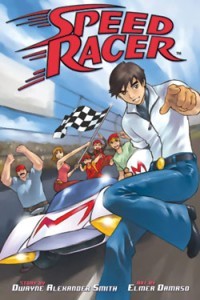
(by Dwayne Alexander Smith and Elmer Damaso, Seven Seas, $9.99)
FROM THE BACK COVER:
"Speed and his friends are back in a rip-roaring original manga that includes thrilling races, a mad scientist, a killer robot, and the destruction of the Mach 5 itself!
The big question is: is it the man that makes the machine or the machine that makes the man?"
EVIDENCE FOR:
I think they had me at "killer robot." Say what you will about the cheese factor and jumping on the movie hype-train, but this re-interpretation of Speed Racer is the perfect action-adventure with its over-the-top gadgetry and supercharged racing scenes. Elmer Damaso draws with a line as confident as any international artist, whether it's the sleek lines of the Mach 5, the explosions and debris of a heart-pounding chase, or (most strikingly) updating the series' character designs for a modern audience. The pace of the story is decidedly modern as well, going at breakneck speed from track races to car chases to cyborg confrontations and all the plot developments in between—there's even room for a handful of flashbacks that flesh out the characters in surprising ways. If all these "mods" have completely shattered your nostalgia lenses, don't fret: the main cast is still perfectly in character, from Speed's noble courage all the way to the moral ambiguity of Racer X. Ultimately, though, don't think of this one-shot as an attempt to recreate the original TV series—think of it as a daring, action-packed 21st-century update that actually works.
EVIDENCE AGAINST:
Sorry, but slick new character designs and all the 21st-century gadgetry in the world can't change the fact that this is still popcorn entertainment at its most banal. Whether it was inspired by the Wachowskis' script or not, this spinoff story still comes with too many eyeroll-inducing Hollywood clichés: explosive character deaths, cackling villains consumed by their love of technology, a damsel in distress, and a big fancy "final" race to determine the ultimate winner. Seriously, isn't this just a Fast and the Furious movie skinned with a different set of characters? Even the action scenes, which are supposed to be the bread and butter of this book, often end up feeling rushed and confusing—and it would have taken just a few more extra panels between key moments to make those sequences easier to understand. This loud, empty-headed story may excite little boys and little-boys-at-heart, but those of us who grew up with Speed Racer may be disappointed to find that Speed Racer hasn't exactly grown up with us.
FINAL VERDICT:
Okay, so the story's corny and shallow and only one volume long—but there are far worse things in this genre. Anyone who likes fast cars, big explosions and wicked technology will definitely get a kick out of this one.

For our first Reader's Choice, we're going on a historical adventure ... but to an unexpected place and time! Forget about ancient Japan and China; this review by reader Matsurika will take you to the other end of Asia:
RED RIVER
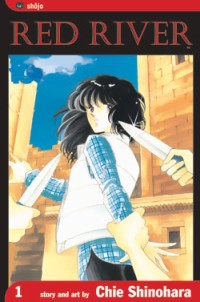
(by Chie Shinohara, Viz, $9.99 ea.)
Red River is the story of a Japanese girl, Yuri, who gets sent back in time to the Hittite Empire, approximately 1300 BC. Although she is brought there as a sacrifice, she, with the help of Prince Kail, is rescued and becomes an influential figure, as the goddess Ishtar, in their politics and history.
This series really excels in its accurate historical story-telling. It's told so well, though the eyes of Yuri, that you feel like you're right there as the events are unfolding. In fact, it's rather hard to be bored with this series, because something exciting is always happening.
I was hooked by this series with the first book. As I read more, I realized that a series as well-written as this one has some serious flaws.
The fact that something is always happening becomes an annoying problem. As soon as one arc gets wrapped up, there's always something else to take its place. The characters have very little downtime to explore themselves or others, which might be okay in other series, but in a romance, where the characters need to spend time getting to know each other, it seems contrived, particularly the interruptions.
The main character, Yuri, is a odd mixture of naïve and assertive. She is often confident and self-assured, ready to do what's necessary, or lead an army, but conversely, when it comes to love, she won't speak her mind, and often assumes things that could be resolved by talking, but she refuses to do so.
I think what it really comes down to is the author has a set idea for what she wants to do, regardless of whether it seems natural or not. That's really too bad. I enjoy this series, but the flaws really keep it from being great.
Is there a hidden gem of manga you'd like to reveal to the world? Is there a piece of garbage that deserves to be bashed in public? Or is there a title that didn't get a fair grade here, and you want to set the record straight?
Now's YOUR chance to be the reviewer! Write a review of 400 words (yes, the limit has been increased) and include:
- Your name
- Title of manga (and volume no., if applicable)
- Author/Artist
- Publisher
- Briefly describe the story, then explain why this manga is great, terrible, or in between. Be objective, but also be entertaining.
Then send it in to rtoreaders (at) gmail (dot) com. One review will be selected out of all the submissions and will be published in the next column. All types of manga and manga-inspired comickry are accepted, from past and present, from Japan and beyond—what matters is that it's the Reader's Choice!
discuss this in the forum (28 posts) |